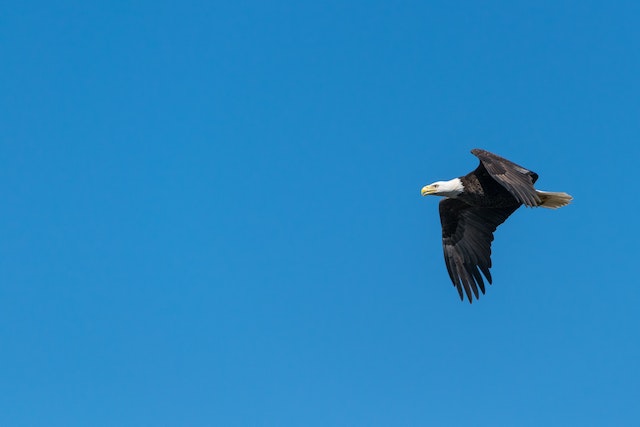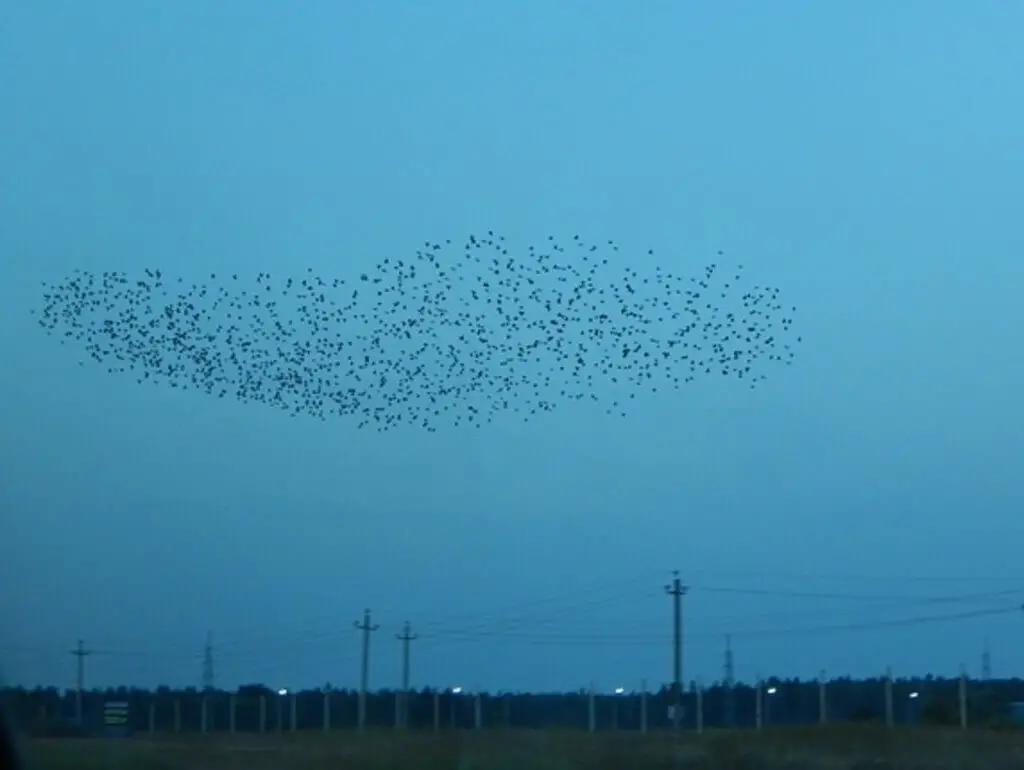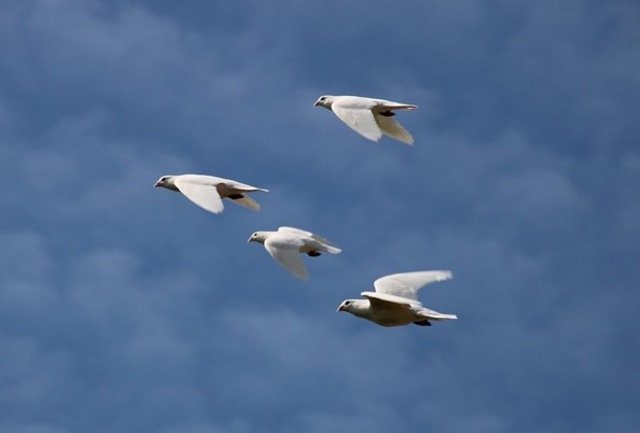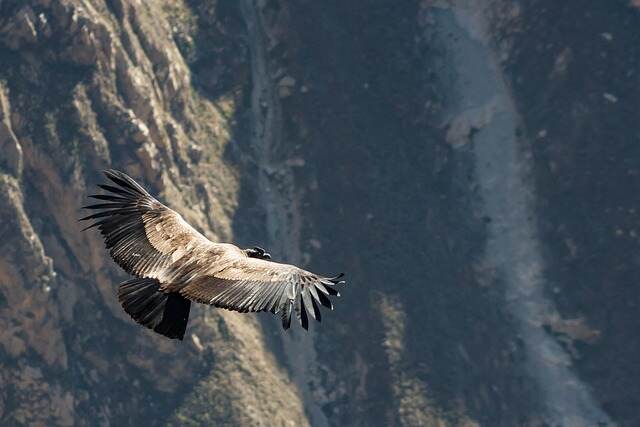Have you ever looked up at the sky and spotted a flock of birds gracefully circling overhead? It’s a mesmerizing sight, but have you ever wondered why they fly in circles? In this article, we will explore the intriguing behavior of birds flying in circles and uncover the reasons behind this phenomenon. We will also delve into the various flight patterns exhibited by avian species.
Table of Contents
- 1 Key Takeaways:
- 2 Why Do Birds Fly In Circles?
- 3 Understanding Avian Circle Flight
- 4 Patterns in Bird Aerial Movements
- 5 Navigation Behavior in Birds
- 6 Natural Instincts and Survival Strategies
- 7 Environmental Factors and Circular Flight
- 8 Social Dynamics and Communication
- 9 The Role of Migration
- 10 Cultural Significance
- 11 Evolutionary Considerations
- 12 Studies and Research Findings
- 13 Uncovering the Secrets of Circular Flight
- 14 Conclusion
- 15 FAQs
- 15.1 What are some examples of circular flight behavior in avian species?
- 15.2 How do birds navigate when flying in circles?
- 15.3 Do environmental factors influence bird flight patterns?
- 15.4 What is the cultural significance of birds flying in circles?
- 15.5 How has circular flight behavior evolved in birds?
- 15.6 What do scientific studies reveal about birds flying in circles?
- 15.7 Are there any symbolic meanings associated with birds flying in circles?
- 15.8 How do circular flight patterns aid bird migration?
- 15.9 What are the advantages of circular flight for birds?
- 16 Author
Key Takeaways:
- Birds flying in circles is a fascinating behavior that has puzzled humans for centuries.
- The circular flight behavior of birds is not limited to any particular species and is observed in various bird families.
- Birds use circular flight for various purposes such as navigation, communication, predator avoidance, and group cohesion.
- External factors such as weather conditions, geographical features, and migration patterns also influence bird flight patterns.
- Studies and research findings have contributed to unraveling the secrets of circular flight in birds.

Why Do Birds Fly In Circles?
Birds can fly in circles for a variety of reasons. It’s a common strategy for reorientation, especially during migration, or for utilizing thermals to conserve energy. Circular flight can also aid in feeding, territorial defense, and courtship displays.
In some cases, it may result from navigation errors or delays. While such behavior often serves specific purposes, persistent circular flight without a clear reason could indicate disorientation or injury, requiring attention to ensure the bird’s welfare.
Understanding Avian Circle Flight
One of the most mesmerizing behaviors exhibited by birds is their circular flight. This avian circle flight is commonly observed when flocks of birds create fascinating circular patterns in the sky. This circular flight behavior of birds has long puzzled scientists, but recent research has shed light on the significance of this behavior in their social dynamics.
Unpacking Avian Circle Flight
Avian circle flight is a phenomenon where a flock of birds fly in a circular pattern. This behavior is not restricted to a particular species, and can be observed in many different types of birds. It typically occurs when birds are foraging, migrating, or roosting.
Bird flock circles can vary in size, with some being only a few meters in diameter, while others may span several hundred meters. The patterns formed by the birds can be either tight or loose, with individual birds flying in a synchronized manner with their neighbors. Some birds even change positions within the circle during flight.
The Significance of Bird Flock Circles
Scientists believe that circular flight behavior of birds plays a crucial role in their social dynamics. It promotes cohesion within the flock and helps birds locate and communicate with each other. The circular pattern also helps birds conserve energy during long flights, by taking advantage of the air currents generated within the vortex.
This behavior may also discourage predators from attacking the flock, as the sheer number of birds and the complex circular pattern can make it difficult for a predator to isolate and target a single bird.
In conclusion, avian circle flight is a fascinating behavior that showcases the complex social dynamics and survival strategies of birds. By understanding this behavior, scientists are gaining valuable insights into the natural world around us.
Patterns in Bird Aerial Movements
Observing birds flying in circles is a mesmerizing sight, but there is more to this behavior than meets the eye. Various avian species exhibit different circular flight patterns, and each pattern may serve a specific purpose.
For instance, some birds create elaborate spiral patterns while soaring in the sky. These patterns may help them gain altitude while conserving energy, as the spirals allow them to ride on thermal updrafts. Other birds, such as starlings, form large flocks that create intricate and synchronized circular patterns in the sky. This behavior serves both social and anti-predator functions, as forming a tight formation makes it harder for predators to single out and capture individual birds.
Another circular flight pattern observed in some birds is the Hammerhead display. This behavior involves the bird flying in large circles with deep swoops, resembling a hammerhead shark’s head motion. The display is part of the courtship behavior of some bird species and is used to attract potential mates.
Overall, the circular flight behavior of birds is an intricate and fascinating subject. By studying bird aerial movements and their circular flight patterns, scientists can gain insights into the underlying mechanisms shaping these behaviors and the evolutionary advantages they provide.
One of the most intriguing aspects of circular flight in birds is its connection to navigation behavior. Birds often use circular flight as a navigational aid, helping them to locate food sources, water, and suitable habitats. This behavior is particularly prominent in migratory birds, who rely on a range of navigational cues to make their long-distance journeys.
There are several reasons why birds may choose to fly in circles as part of their navigation strategy. For example, flying in a circular pattern can help birds to conserve energy by minimizing the distance they need to travel. It can also assist them in maintaining their course by providing a visual reference point, such as a distant landmark or the position of the sun.
Furthermore, circular flight can help birds to detect and avoid potential hazards, such as weather systems or predators. By staying in a circular path, birds can maintain a heightened level of awareness of their surroundings and respond quickly to changes in their environment.
Researchers have also suggested that circular flight may play a role in social communication among birds. For example, circular patterns in flock movements may help birds to coordinate their movements and maintain social cohesion, particularly during migration or other group movements.
In addition to these factors, the decision to fly in circles may be influenced by individual preferences or instincts. Some bird species may simply be more inclined to engage in circular flight, perhaps as a result of their evolutionary history or unique environmental pressures.
Overall, the connection between circular flight and navigation behavior in birds is a complex and multifaceted subject. By continuing to study and learn from these fascinating creatures, we may gain valuable insights into the natural world and the processes that shape it.
Natural Instincts and Survival Strategies
The circular flight behavior of birds is not just a mesmerizing sight, but also serves a variety of natural instincts and survival strategies.
One reason why birds engage in circular flight is to forage for food. Circular flight allows birds to cover a larger area and search for prey or food sources more efficiently. Some bird species are known to use circular flight to locate insect swarms or schools of fish.
Another reason for circular flight is predator avoidance. By flying in circles, birds can confuse predators and make it harder for them to single out a target. This behavior is common among birds that are targeted by aerial predators, such as hawks or eagles.
Circular flight can also aid in group cohesion and communication. By flying in circles, birds can synchronize their movements and communicate information about food sources or potential threats. This behavior is particularly important during mating season or when raising young.
Finally, circular flight may also serve as a natural instinct and survival strategy during migration. Birds that engage in circular flight during migration may do so to conserve energy or navigate more efficiently. This behavior is particularly useful during long-distance journeys, where birds need to conserve energy and avoid unnecessary detours.
The natural instincts and survival strategies associated with circular flight highlight the complexity of avian behavior, and the importance of understanding the various factors that influence bird flight patterns.
Environmental Factors and Circular Flight
Many environmental factors can influence the circular flight behavior of birds. Weather conditions, for example, can play a significant role in the frequency and duration of this flight pattern. Birds may fly in circles to conserve energy during long migratory journeys, taking advantage of favorable winds to maintain altitude and direction. Conversely, during adverse weather conditions, birds may engage in circular flight as a survival mechanism, seeking to avoid strong winds or storms.
Geographical features such as mountains or coastlines can also impact bird flight patterns. Some bird species may fly in circles over specific landmarks or locations, perhaps using them as navigational aids or foraging hotspots. Other species may engage in circular flight to defend their territories or communicate with other birds, using distinct patterns and behaviors to convey different messages.
Human-made structures such as buildings or power lines can also alter bird flight behavior, as some species may choose to fly in circles around these structures or avoid them altogether. Noise pollution and other human activities can also impact bird behavior, potentially causing disruptions or changes in their flight patterns.
Overall, the environmental factors that influence circular flight behavior in birds are complex and varied. As researchers continue to study this fascinating behavior, we gain a deeper understanding of the intricate ways in which birds interact with their surroundings and adapt to changing conditions in their environment.
Social Dynamics and Communication
The circular flight behavior of birds plays a crucial role in their social dynamics and communication among flock members. When birds fly in circles, it creates mesmerizing patterns in the sky that enhance group cohesion and communication.
Group members use these circular flight patterns to exchange information about food sources, predators, and other environmental factors. They also use it for mating displays, where males show off their aerial agility to attract females.
Research has shown that birds often synchronize their movements during circular flight, which requires a high level of communication and cooperation among flock members. This synchronization helps to reduce collisions and ensure smooth flight patterns.
Bird flock circles also play an essential role in predator avoidance. When a predator approaches, a flock can quickly change their circular flight pattern to evade the threat. This coordinated behavior enhances the survival chances of the group members.
The social dynamics and communication aspects of avian circle flight are fascinating and continue to captivate researchers and bird enthusiasts alike. By studying this behavior further, we can gain a deeper understanding of the complex relationships between birds and their environment.
The Role of Migration
Migration is an essential part of the life cycle of many bird species, allowing them to breed, forage, and survive in different environments. While migration patterns vary considerably across avian species, several types of birds are known to engage in circular flight as part of their migration strategy.
One possible reason for birds to fly in circles during migration is to conserve energy. Circular flight patterns enable birds to fly in thermals or updrafts, reducing the amount of energy expended during long journeys. In addition, circular flight may allow birds to adjust their altitude and direction more efficiently, enabling them to navigate through changing wind patterns.
Another explanation for circular flight during migration is related to navigation behavior. Birds may use circular flight as a means of correcting their route and orient themselves based on the position of the sun, stars, or landmarks. Some species of birds, such as the Arctic Tern, may fly in circles over their nesting grounds, providing visual cues for navigation.
Moreover, circular flight may play a role in group behavior and flock cohesion during migration. Some bird species fly in large flocks, circling together in the sky as a means of communication and coordination. By maintaining a circular flight pattern, birds can remain in close proximity to one another, sharing information about food sources and potential hazards.
In summary, circular flight is an essential part of bird migration and offers several advantages, including energy conservation, navigation assistance, and flock cohesion. By understanding the role of circular flight in bird migration, we can gain greater insight into the complex strategies and adaptations of these remarkable avian species.
Cultural Significance
The circular flight patterns of birds have captured the imaginations of people across cultures throughout history. The sight of flocks of birds soaring and swirling in the sky is a mesmerizing sight that has inspired art, literature, and mythology.
In some Native American cultures, circular flight patterns are seen as a symbol of the infinite cycle of life and death, representing the eternal nature of the universe. In Hindu mythology, Garuda, the bird deity, is often depicted with circular flight patterns, representing both his power and grace.
Additionally, birds flying in circles have been associated with a range of cultural beliefs and superstitions. In some cultures, it is said that seeing birds flying clockwise is an omen of good luck, while counterclockwise flight is a sign of impending danger.
The cultural significance of circular flight patterns in birds is a testament to the enduring fascination people have with the natural world. As we continue to explore and understand the complexities of avian behavior, it is certain that these flight patterns will continue to inspire and captivate us for generations to come.
Evolutionary Considerations
As we explore the circular flight patterns in avian species, it’s important to consider the evolutionary aspects of this behavior. Scientists have long studied the adaptive advantages of bird aerial movements, with circular flight being no exception.
One hypothesis suggests that circular flight is an effective strategy for foraging. Birds can cover large areas and effectively search for food using this flight pattern, allowing them to efficiently locate and capture prey. Additionally, circular flight may provide a means for predator avoidance, as it makes it more challenging for predators to target an individual bird within a flock.
Other researchers propose that the circular flight is essential for social dynamics and mating displays. Some species of birds perform intricate aerial displays involving circular flight patterns as part of their courtship rituals. This suggests that circular flight has played a role in sexual selection and the evolution of mating behaviors.
Furthermore, circular flight may have relevance to the evolution of birds’ cognitive abilities and their capacity for navigation. This behavior could have served as a precursor to more complex navigation behaviors that evolved over time, such as long-distance migration patterns.
Overall, the evolutionary considerations of circular flight highlight the importance of understanding avian flight patterns and behaviors in a broader ecological context.
Studies and Research Findings
Scientists have been studying the circular flight behavior of birds for decades, attempting to unravel the complex reasons behind this mesmerizing behavior. Through extensive research and observation, a range of fascinating findings have emerged, shedding new light on this intriguing phenomenon.
One notable study conducted by researchers at the University of Bristol examined the circular flight patterns of European starlings. By tracking the movements of individual birds within a flock, the researchers found that each bird adjusted its flight trajectory to stay close to its neighbors. This produced the mesmerizing, fluid, and ever-changing circular patterns that starling flocks are known for, showcasing their remarkable synchronized flight and murmuration abilities.
Other studies have explored the navigational benefits of circular flight. Some researchers have suggested that birds use this flight pattern as a way to help them track their position in the environment, particularly when they are migrating long distances. By observing the movement of stars and other celestial bodies, birds can use circular flight to orient themselves and stay on course.
Another fascinating finding is the role that circular flight plays in social communication among birds. Research has shown that certain species use circular flight patterns as part of their mating displays, with males performing intricate aerial maneuvers to impress potential mates. In some cases, the circular flight patterns are also used to signal other flocks of birds in the area, indicating the presence of food or potential dangers.
Overall, studies and research findings have offered valuable insights into the behavior of birds flying in circles. From navigation and survival strategies to social dynamics and communication, this fascinating behavior remains a rich area for further investigation and exploration.
Uncovering the Secrets of Circular Flight
As we have explored in this article, the circular flight behavior of birds is a fascinating phenomenon shaped by various factors, including navigation, social dynamics, survival strategies, migration, and cultural significance.
Through extensive research and scientific studies, we continue to unravel the intricate secrets behind this avian aerial acrobatics, offering a deeper understanding of the natural world around us.
Insights from Research Findings
Scientists have conducted numerous studies to decode the secrets of circular flight in birds. For instance, a recent research study conducted by a team of scientists at Oxford University found that birds flying in circles follow simple rules based on the position and movement of neighboring birds.
The study also found that circular flock flight was more efficient in terms of energy consumption, allowing birds to conserve energy during long flights. Another study by German scientists investigated the social dynamics involved in circular flock flight.
They observed that groups of birds flying in circles communicate through subtle movements and vocalizations, allowing them to maintain cohesion and avoid collisions.
The Evolutionary Significance
Circular flight in birds has evolved over millions of years, shaped by environmental and ecological factors. For instance, some bird species engage in circular flight as part of their migration patterns, allowing them to navigate through unfamiliar terrain and avoid obstacles.
Others use circular flight as a means of predator avoidance, creating mesmerizing patterns in the sky to confuse and deter potential predators. This behavior is also an effective way of foraging for food, with some species combining circular flight with ground foraging in a coordinated effort.
Interpreting Cultural Significance
Birds flying in circles have captured the imagination of people throughout history, inspiring cultural beliefs and interpretations. For instance, some cultures view circular flight as a symbol of unity and cooperation, while others associate it with spirituality or divine intervention.
In Native American culture, the eagle is revered for its circular flight patterns, seen as a symbol of power, freedom, and spiritual significance. Similarly, in Hindu mythology, the Garuda bird is believed to possess circular flight capabilities as a representation of divine power and speed.

Conclusion
In conclusion, the circular flight behavior of birds is a complex and fascinating insight into the natural world around us. Understanding the various factors that contribute to this behavior helps us gain a deeper appreciation of the diverse and intricate ways in which living organisms interact with their environment.
Through ongoing research and scientific study, we continue to uncover the secrets of circular flight in birds, unlocking a greater understanding of their habits and behaviors. As we unravel these mysteries, we deepen our connection with the wondrous world of nature.
FAQs
What are some examples of circular flight behavior in avian species?
Some avian species known for their circular flight patterns include starlings, swallows, sparrows, and pigeons. These birds often form mesmerizing flocks that create intricate circular shapes in the sky.
Birds may use a combination of visual cues, landmarks, and magnetic fields to navigate when flying in circles. Circular flight patterns can help them maintain a sense of direction and stay on course during long-distance journeys.
Do environmental factors influence bird flight patterns?
Yes, environmental factors such as weather conditions and geographical features can impact the frequency and duration of circular flight in birds. Certain habitats or migration routes may be more conducive to this behavior due to the availability of resources or favorable wind patterns.
What is the cultural significance of birds flying in circles?
The cultural significance of birds flying in circles varies across different societies and beliefs. In some cultures, circular flight patterns may be associated with spirituality, transformation, or symbolize the cyclical nature of life. Others may interpret it as a sign of good luck or divine presence.
How has circular flight behavior evolved in birds?
Circular flight behavior in birds has likely evolved over time as an adaptive strategy for survival and efficient movement. Birds with strong circular flight capabilities may have had an advantage in terms of foraging efficiency, predator avoidance, and group coordination, leading to its persistence throughout evolution.
What do scientific studies reveal about birds flying in circles?
Scientific studies have shed light on various aspects of circular flight behavior in birds. Researchers have investigated factors such as flock dynamics, navigation strategies, communication patterns, and the physiological adaptations that enable birds to engage in this behavior. These studies contribute to our understanding of avian behavior and the underlying mechanisms behind circular flight.
Are there any symbolic meanings associated with birds flying in circles?
Symbolic meanings attributed to birds flying in circles can vary across cultures and belief systems. In some contexts, it may represent unity, harmony or the cyclical nature of life. Others may interpret it as a sign of divine intervention, spiritual guidance, or a message from the natural world.
How do circular flight patterns aid bird migration?
Circular flight patterns can assist birds during migration by conserving energy and maintaining a consistent heading. By flying in circles, birds can take advantage of updrafts and wind currents, reducing the physical exertion required for long-distance journeys.
What are the advantages of circular flight for birds?
Circular flight patterns offer several advantages for birds, including efficient foraging, predator detection, and group coordination. By flying in circles, birds can maintain visual contact with each other, communicate effectively, and respond quickly to threats or opportunities in their environment.






